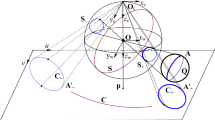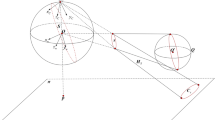Abstract
Central catadioptric cameras are imaging devices that use mirrors to enhance the field of view while preserving a single effective viewpoint. Lines and spheres in space are all projected into conics in the central catadioptric image planes, and such conics are called line images and sphere images, respectively. We discovered that there exists an imaginary conic in the central catadioptric image planes, defined as the modified image of the absolute conic (MIAC), and by utilizing the MIAC, the novel identical projective geometric properties of line images and sphere images may be exploited: Each line image or each sphere image is double-contact with the MIAC, which is an analogy of the discovery in pinhole camera that the image of the absolute conic (IAC) is double-contact with sphere images. Note that the IAC also exists in the central catadioptric image plane, but it does not have the double-contact properties with line images or sphere images. This is the main reason to propose the MIAC. From these geometric properties with the MIAC, two linear calibration methods for central catadioptric cameras using sphere images as well as using line images are proposed in the same framework. Note that there are many linear approaches to central catadioptric camera calibration using line images. It seems that to use the properties that line images are tangent to the MIAC only leads to an alternative geometric construction for calibration. However, for sphere images, there are only some nonlinear calibration methods in literature. Therefore, to propose linear methods for sphere images may be the main contribution of this paper. Our new algorithms have been tested in extensive experiments with respect to noise sensitivity.
Similar content being viewed by others
Explore related subjects
Discover the latest articles, news and stories from top researchers in related subjects.References
Agrawal, M., & Davis, L. S. (2003). Camera calibration using spheres: a semi-definite programming approach. In Proceedings of the IEEE international conference on computer vision (pp. 782–791).
Aliaga, D. G. (2001). Accurate catadioptric calibration for real-time pose estimation of room-size environments. In Proceedings of the international conference on computer vision (pp. 127–134).
Baker, S., & Nayar, S. (1998). A theory of catadioptric image formation. In Proceedings of IEEE international conference on computer vision (pp. 35–42), Bombay.
Barreto, J. P., & Araujo, H. (2001). Issues on the geometry of central catadioptric imaging. In Proceedings of the IEEE international conference on computer vision and pattern recognition, Kauai, HI, USA.
Barreto, J. P., & Araujo, H. (2005). Geometric properties of central catadioptric line images and their application in calibration. IEEE Transactions on Pattern Analysis and Machine Intelligence, 27(8), 1327–1333.
Barreto, J. P., & Araujo, H. (2006). Fitting conics to paracatadioptric projection of lines. Computer Vision and Image Understanding, 101(3), 151–165.
Bogner, S. (1995). An introduction to panospheric imaging. In Proceedings of the IEEE conference systems, man, and cybernetics (pp. 3099–3116), Vancouver, BC.
Evelyn, C. J. A., Money-Coutts, G. B., & Tyrrell, J. A. (1974). The seven circles theorem and other new theorems. London: Stacey International.
Fitzgibbon, A., Pilu, M., & Fisher, R. (1999). Direct least square fitting of ellipses. IEEE Transactions on Pattern Analysis and Machine Intelligence, 21(5), 476–480.
Geyer, C., & Daniilidis, K. (1999). Catadioptric camera calibration. In Proceedings of the international conference on computer vision (pp. 398–404), Kerkyra, Greece, 20–23 September 1999.
Geyer, C., & Daniilidis, K. (2001). Catadioptric projective geometry. International Journal of Computer Vision, 43, 223–243.
Geyer, C., & Daniilidis, K. (2002). Paracatadioptric camera calibration. IEEE Transactions on Pattern Analysis and Machine Intelligence, 24(5), 687–695.
Gluckman, J., & Nayar, S. K. (2001). Catadioptric stereo using planar mirrors. International Journal of Computer Vision, 44(1), 65–79.
Hartley, R., & Zisserman, A. (2000). Multiple view geometry in computer vision. Cambridge: Cambridge University Press.
Hecht, E., & Zajac, A. (1997). Optics (3rd ed.). Reading: Addison–Wesley.
Hong, J., Tan, X., Weiss, R., & Riseman, E. (1991). Image-based homing. In IEEE international conference robotics and automation (pp. 620–625).
Kang, S. (2000). Catadioptric self-calibration. In IEEE conference computer vision and pattern recognition (pp. 201–207), Hilton Head Island, SC, 13–15 June 2000.
Nalwa, V. S. (1996). A true omnidirectional viewer. Technical Report, Bell Laboratories, Holmdel, NJ 07733, USA.
Nayar, S. K. (1988). Sphereo: Recovering depth using a single camera and two specular spheres. In Proceedings of SPIE: optics, illumination, and image sensing for machine vision II.
Nene, S., & Nayar, S. (1998). Stereo with mirrors. In Proceeding international conference on computer vision (pp. 1087–1094), Bombay, India, 3–5 January, 1998.
Semple, J., & Kneebone, G. (1952). Algebraic projective geometry. Oxford: Oxford Science.
Svoboda, T., Pajdla, T., & Hlavac, V. (1998). Epipolar geometry for panoramic cameras. In Proceedings of the 5th European conference on computer vision (pp. 218–231).
Swaminathan, R., Grossberg, M. D., & Nayar, S. (2006). Non-single viewpoint catadioptric cameras: geometry and analysis. International Journal of Computer Vision, 66(3), 211–229.
Teramoto, H., & Xu, G. (2002). Camera calibration by a single image of balls: from conics to the absolute conic. In Proceedings Asian conference computer vision (pp. 499–506).
Yagi, Y., & Kawato, S. (1990). Panorama scene analysis with conic projection. In Proceedings of IEEE/RSJ international workshop on intelligent robots and systems (pp. 181–187).
Yagi, Y., & Yachida, M. (2004). Real-time omnidirectional image sensors, International Journal of Computer Vision 58(3), 173–207.
Ying, X., & Hu, Z. (2004). Catadioptric camera calibration using geometric invariants. IEEE Transactions on Pattern Analysis and Machine Intelligence, 26(10), 1260–1271.
Ying, X., & Zha, H. (2005). Linear approaches to camera calibration from sphere images or active intrinsic calibration using vanishing points. In Proceedings of IEEE international conference on computer vision (pp. 596–603), China.
Ying, X., & Zha, H. (2006). Geometric interpretations of the relation between the image of the absolute conic and sphere images. IEEE Transactions on Pattern Analysis and Machine Intelligence, 28(12), 2031–2036.
Zhang, H., Wong, K., & Zhang, G. (2007). Camera calibration from images of spheres. IEEE Transactions on Pattern Analysis and Machine Intelligence, 29(3), 499–503.
Author information
Authors and Affiliations
Corresponding author
Rights and permissions
About this article
Cite this article
Ying, X., Zha, H. Identical Projective Geometric Properties of Central Catadioptric Line Images and Sphere Images with Applications to Calibration. Int J Comput Vis 78, 89–105 (2008). https://doi.org/10.1007/s11263-007-0082-8
Received:
Accepted:
Published:
Issue Date:
DOI: https://doi.org/10.1007/s11263-007-0082-8




